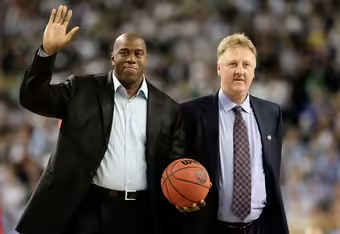If the Miami Heat make the Finals, there’s no doubt NBA commissioner David Stern and the executives at ABC and ESPN will burn a little incense to the basketball marketing gods. Nothing is likely to draw bigger ratings than the drama of LeBron James, Dwyane Wade and Chris Bosh competing for the title in their first season together.
They also can’t help but being a little disappointed that Kobe Bryant and the Los Angeles Lakers were so easily cashiered by the Dallas Mavericks, leaving a relative lack of star power among the Western Conference contenders.
Since 1984, Stern’s first year as the head of the league, the gold standard for the Finals has been to have teams with big stars and huge personalities to pump up drama and draw viewers—not that much different than the way pro wrestling deliberately manufactures feuds between its stars.
When the matchups don’t raise the pulse—think of the San Antonio Spurs vs. the New Jersey Nets in 2003—the ratings are dismal. Sadly, for all his reliability and consistent play, it’s doubtful that Tim Duncan has ever kept anyone glued to the TV.
This model of basketball as big-time entertainment rode in on the backs of two men, of course: Earvin “Magic” Johnson and Larry Bird. They not only redefined the game for the modern television era but did so while unwittingly shouldering much of the country’s racial baggage.
In doing so, they capped a period of basketball’s development and stamped their personalities on a decade. By the time they were done, the game was speeding on from where they’d brought it.
They were a bridge between the old and the new, their impact inseparable from the place both pro basketball and the country were when they emerged into the spotlight three decades ago.
From 1950 to 1980, the NBA had transformed from all-white to majority black, from a stolid half-court game to one played full court, on the run and above the rim. White superstars who could play this style—such as Jerry West, John Havlicek and Pete Maravich—were in short supply.
During the 1970s, after the retirement of Bill Russell and Wilt Chamberlain, the league fell into the doldrums, failing to land a good television contract and playing to half-full arenas.
Many of the NBA’s travails were attributed to racial factors: It was thought that white fans would not support a “black” league, and the black game was said to be “selfish” and not team-oriented. At the same time, stories spread about widespread cocaine use in the league.
Beyond the court, the aftermath of the civil rights movement was playing out. It turned out that the most straightforward civil rights achievements came in passing the laws that ended direct segregation and discrimination in the South, with landmarks such as the 1965 Voting Rights Act.
In the 1970s, activists moved to push the movement’s goals ahead outside of the South. They advocated for solutions such as mandatory busing to desegregate urban schools and affirmative action to give blacks access to jobs from which they’d been traditionally blocked.
There was a ferocious push back to this from whites. Many who could afford it simply fled to the suburbs.
In addition, ideas such as “reverse racism” and complaints about “fairness” began to be talked about among whites—no matter that such notions disregarded the fact that African Americans had been kept from jobs, schooling and decent housing for centuries by both custom and law.
To make matters worse, the manufacturing jobs that had provided the foundation for the American working and middle classes were being hacked away, shipped to foreign countries with cheaper labor or made obsolete by technology.
This was the environment Bird and Magic entered when they stepped onto the national stage in 1979. Both, as it happened, emerged from America’s embattled working classes.
From Blue-Collar Backgrounds to the NCAA Championship
Earvin “Magic” Johnson grew up outside Detroit in Lansing, Mich., one of seven children. His family had moved up from the South in the 1950s to look for jobs in the auto plants. Johnson’s father worked the assembly line night shift at General Motors. To bring in some extra cash, he started a trash hauling business on the side.
Though the family was always stretched for money, Johnson remembered it as an idyllic time. “I grew up in the type of black family people today worry is disappearing,” he wrote. “We had what we needed. Two great parents, food on the table and time for the whole family to be together.”
By seemingly the recounting of everyone who knew him, Johnson was a jovial kid who loved two things: garnering attention and playing basketball. He focused on the game from an early age, hitting the local court at 6 in the morning before elementary school to get in some practice.
In high school, Johnson was bused to a majority-white high school where racial tensions ran high—blacks and whites simply did not associate, except to fight. But Johnson’s easygoing demeanor and basketball skills made him so much of a bridge that the principal often asked him to play peacemaker.
Though Johnson could have taken his pick of college scholarships, he decided to stay home and attend Michigan State.
Larry Bird grew up less than 400 miles away in tiny, rural French Lick, Ind. He was one of six kids in a poor family that was lower down the economic scale than Johnson’s.
Bird’s mother worked as a waitress and a cook. His father, a Korean War veteran, took odd jobs but was often out of work. At times when he did have a job, he went to the bar and drank his paycheck.
A withdrawn, shy kid, Bird found an outlet in basketball. At 13, he visited his aunt in another part of Indiana, got in a pickup game and dominated. The other kids on his team slapped him on the back, told him he was great and asked Bird to keep playing with them. Bird later called it “the day I fell in love with basketball.”
Like Magic, Bird became a heavily recruited high school basketball star. He took a scholarship to play for Bobby Knight at Indiana, but found the adjustment from rural poverty to university jarring.
“I had no money—and I mean no money. I arrived there with $75,” Bird wrote. “I had virtually no clothes.”
After only 24 days, he dropped out and hitchhiked home. When he arrived back in French Lick, his mom refused to speak to him for months.
Bird took a job with the municipality, cutting grass, painting park benches and driving a garbage truck. He also played AAU basketball, destroying competition across Indiana.
The next year, Bird returned to college at Indiana State University, 75 miles away in Terre Haute. He found the down-home atmosphere there suited him.
Michigan State and Indiana State were not college basketball powerhouses. But as they would later do in the NBA, Magic and Bird immediately energized the programs.
In his freshman year, Johnson took a team that had been 10-17 the previous season and led it to a 25-5 record, its first Big Ten championship in two decades and the Elite Eight.
Indiana State had been 12-14 in the two seasons before Bird arrived. For the three years he played there—he had to sit out his first year due to NCAA rules—ISU went 81-13.
In 1979—the end of Johnson’s second year playing for Michigan State and Bird’s third at Indiana State—the pair led their teams to the NCAA championship game. Michigan State won 75-64.

